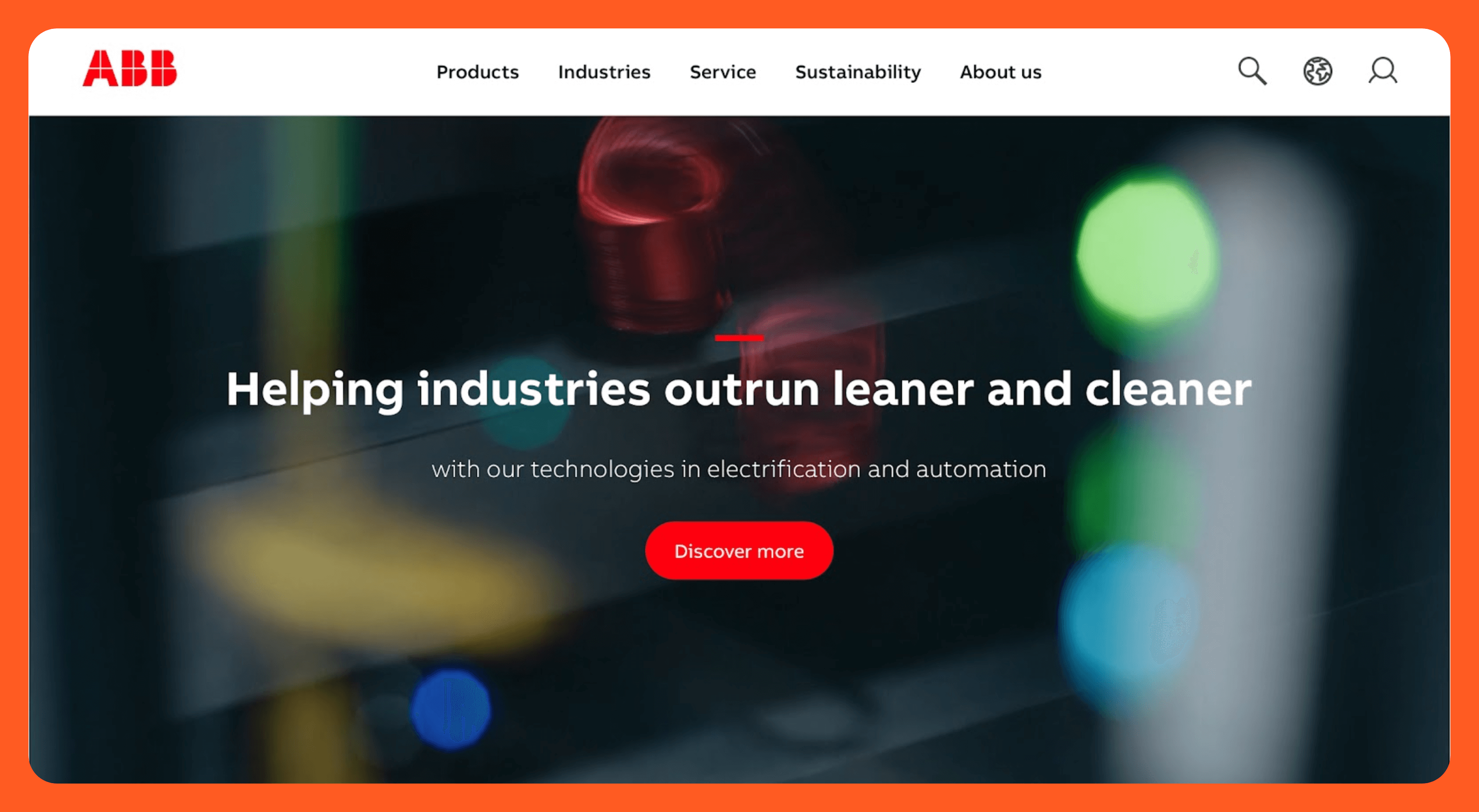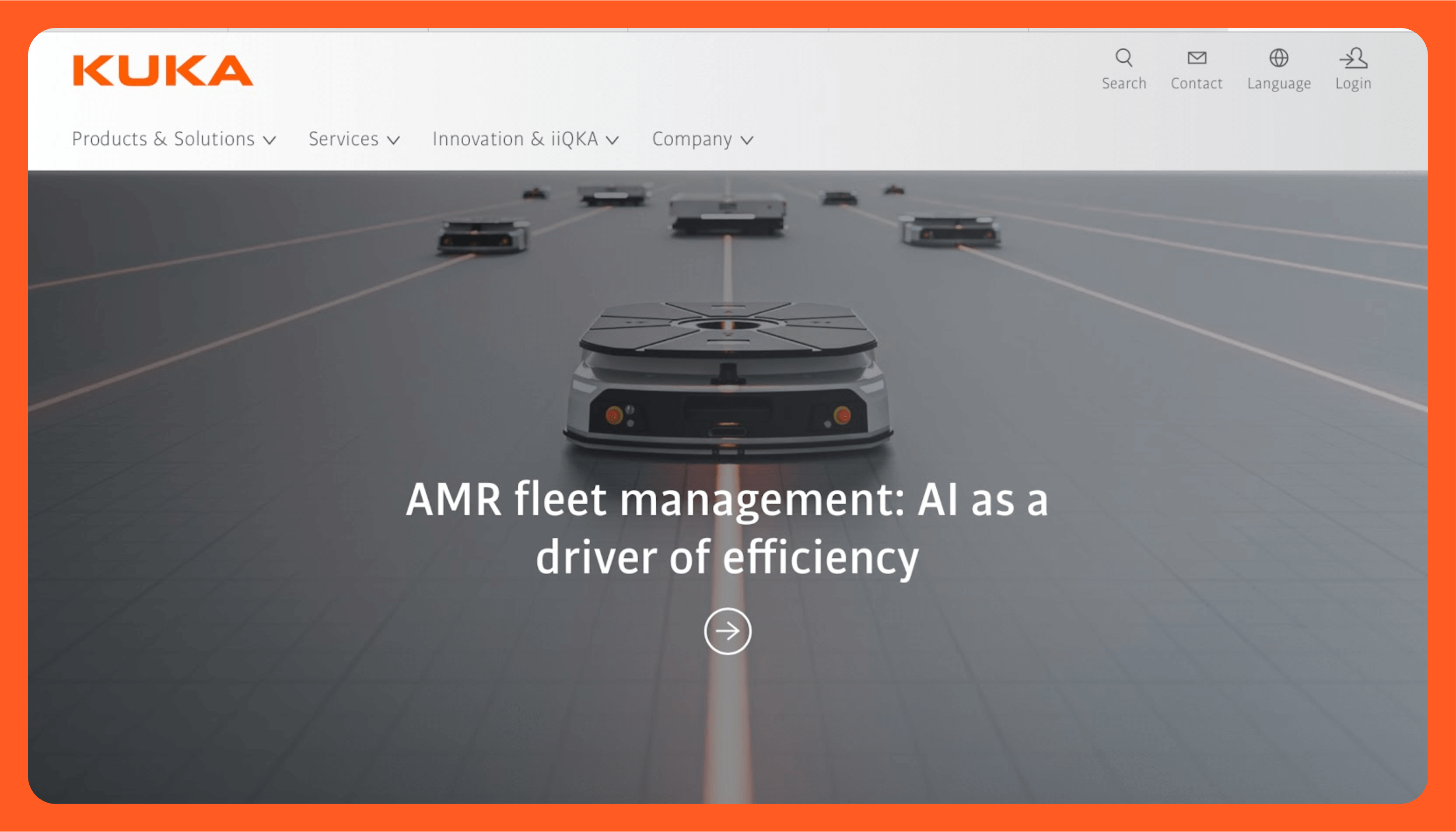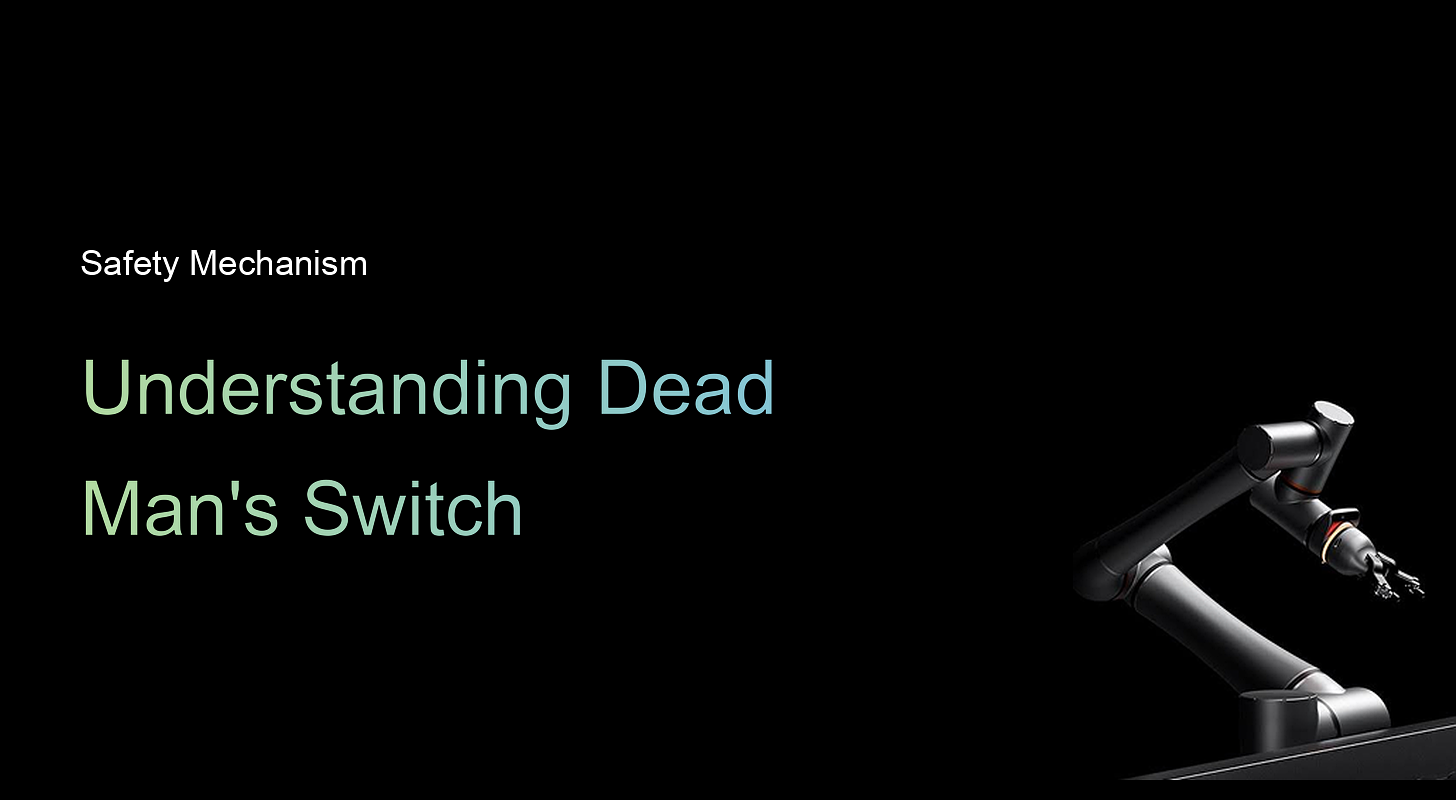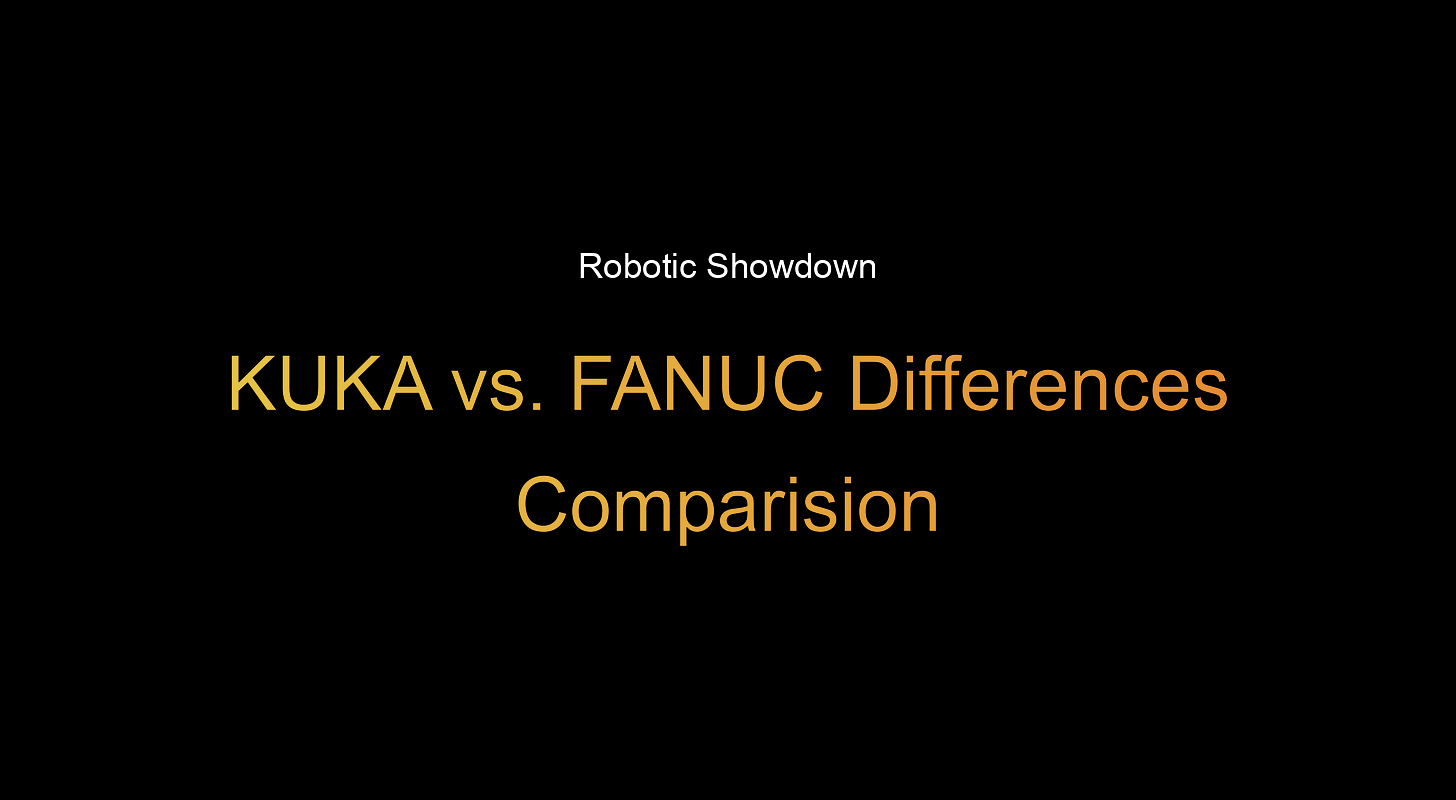Companies like ABB (≈14%) and KUKA (≈13%) together hold roughly 27% of the global industrial robot market.
This means they are two of the most influential players in automation. The real question isn’t “Which brand is better” but rather, “Which one works best for your workflow, integration setup, and long‑term ROI?”
ABB vs. KUKA: TL;DR
What is an industrial robot?
An industrial robot is a reprogrammable, multipurpose manipulator designed to perform repetitive tasks in industrial settings, often involving material handling, assembly, or other manufacturing processes. Think of it as a tireless teammate that boosts productivity, nails precision, and takes on the heavy, repetitive, or risky jobs so your team does not have to.
These robots usually fall into categories like:
- Articulated arms mimic a human arm with 6+ axes of movement.
- Delta robots use parallel-link arms for ultra-high-speed sorting and packing.
- SCARA robots are ideal for fast, lateral movements in pick-and-place or assembly lines.
- Collaborative robots (or cobots) are designed to work safely alongside human operators.
Brand and product overview
ABB Robotics

Founded in 1988 through the merger of Sweden’s ASEA and Switzerland’s BBC Brown Boveri, ABB Robotics is now one of the “big four” in industrial automation. Headquartered in Zurich, it operates in over 50 countries and maintains more than 400,000 robot installations globally.
ABB’s strength lies in its combination of hardware reliability and deep software integration, especially for discrete manufacturing and heavy industries.
Popular ABB robot series:
- IRB Series
ABB’s core industrial line includes models like the IRB 1300 and IRB 6700. These robots offer payloads from 7 kg to over 300 kg and are known for their durability and flexibility. The IRB 6700, for instance, is optimized for heavy-duty tasks like spot welding and palletizing.
- ABB YuMi (dual-arm and single-arm)
Designed for safe, collaborative tasks, ABB YuMi is a lightweight cobot built for precision assembly in tight spaces.
- IRB 8700
IRB 8700 is one of ABB’s most powerful robots, handling up to 800 kg payloads. It’s built for large-part handling in industries like shipbuilding and metal fabrication.
- OmniCore Controllers
These next-gen controllers support faster cycle times and higher precision, while being compact and energy-efficient. Omnicore controllers bring a notable shift for manufacturers aiming to reduce floor space.
KUKA Robotics

KUKA, founded in 1898 in Germany, originally started with welding systems before entering robotics in the 1970s. It was one of the first to develop six-axis electric robots and now stands as a global leader with a strong foothold in the automotive sector. KUKA was acquired by China’s Midea Group in 2016 but remains headquartered in Augsburg, Germany.
Popular KUKA robot series:
- KR AGILUS
KR AGILUS is a high-speed compact robot series for light assembly, packaging, and electronic component handling. Known for extreme speed and repeatability in constrained spaces.
- KR QUANTEC
KR QUANTEC is KUKA’s flagship series for mid- to high-payload tasks (90 to 300 kg), widely used in welding, machining, and heavy assembly lines. It offers modular configurations and long reach options.
- LBR iiwa (intelligent industrial work assistant)
One of the most advanced collaborative robots on the market, the LBR iiwa is equipped with sensitive torque sensors at each joint, allowing it to perform precise and safe movements even in human-dense environments.
- KUKA Ready2 Systems
Preconfigured application packages (e.g., Ready2_pilot, Ready2_arc) allow faster deployment for welding, palletizing, and more.
Industry presence
Both ABB and KUKA have decades of experience in automation, but they’ve carved out slightly different footprints across industries.
ABB’s industrial reach
- Automotive: Strong in paint shops, spot welding, and final assembly.
- Electronics: Used for precision assembly, soldering, and inspection.
- Pharma & food: Gaining traction in secondary packaging and material handling.
- Metalworking: Commonly deployed in arc welding, bending, and cutting applications.
ABB’s strength lies in breadth. It’s often favored by global manufacturers looking for a reliable, all-purpose automation partner with strong simulation and digital twin capabilities.
KUKA’s industrial reach
- Automotive: A top-tier player in body-in-white welding, material handling, and part transfer.
- Aerospace & metals: Preferred for heavy-payload operations, like riveting and composite machining.
- Electronics: Growing presence in battery manufacturing, PCB assembly, and semiconductor handling.
- Warehousing & logistics: With its KR CYBERTECH and mobile platform solutions, KUKA is investing heavily in smart warehousing applications.
KUKA tends to win with OEMs that need deep customization and high-speed performance in industrial or semi-industrial settings.
Technical performance
KUKA often leads in payload-to-weight ratio and reach, while ABB offers more compact footprints with comparable speed and accuracy.
ABB’s IRB 1100 and 1300, for instance, are built for high-speed tasks in small spaces where KUKA’s compact AGILUS series also competes.
Programming and integration
ABB and KUKA take different approaches when it comes to robot programming.
ABB: RobotStudio
ABB’s RobotStudio is a full-featured offline simulation and programming environment. It lets you build, test, and optimize robot programs before deployment with digital twins, CAD import, and collision detection.
- Real-time 3D simulation
- No robot downtime during setup
- Easy PLC and fieldbus integration
- Offers wizard-based workflows for beginners
RobotStudio is a standout for teams needing to simulate entire production cells or test cycle times before committing to hardware.
KUKA: WorkVisual & KRL
KUKA robots are programmed using KUKA WorkVisual, an IDE for configuring devices, managing I/O, and writing programs in KRL (KUKA Robot Language). KUKA also supports external programming using Python or Java via APIs and ROS.
- Modular interface design
- Strong integration with Siemens PLCs
- Higher learning curve but more control
- Offers Ready2 packages for preconfigured tasks
For developers and system integrators, KUKA provides granular control and flexible architecture. This makes it ideal for custom applications.
Automation ecosystem
Both brands offer digital platforms to monitor, manage, and optimize robotic operations. These platforms are increasingly important for predictive maintenance, energy monitoring, and multi-site robot orchestration.
ABB Ability
ABB’s digital layer, ABB Ability, connects robots with enterprise-level analytics and cloud integration.
It includes:
- Predictive maintenance alerts
- Real-time performance dashboard
- Integration with MES/ERP systems
- Condition monitoring via edge computing
It’s part of ABB’s push toward Industry 4.0, especially for large factories using multiple robot cells.
KUKA Connect
KUKA Connect is a cloud-based platform that delivers diagnostics, condition monitoring, and visualization tools through a web browser.
Features include:
- Remote diagnostics
- Cloud-based asset tracking
- Real-time robot health indicators
- Basic API access for third-party apps
KUKA Connect is lighter-weight than ABB Ability but easier to deploy for smaller teams or single-factory users.
For those interested in deeper system coordination, explore how third-party ecosystems like Robotnik expand KUKA’s capabilities.
Collaborative robots
Cobots are increasingly being used in assembly, testing, and pick-and-place tasks, especially where safety and compact design are priorities.
ABB YuMi
ABB’s YuMi cobots are dual-arm and single-arm systems that prioritize gentle handling and human-centric design.
They come with:
- Integrated vision and gripper options
- Lightweight arms for tabletop assembly
- Rounded edges and integrated force sensors
YuMi is often used in electronics, medical device assembly, and small-part kitting. ABB also offers the SWIFTI line, which is a faster cobot for applications needing more speed than YuMi can offer.
KUKA LBR iiwa
KUKA’s LBR iiwa (intelligent industrial work assistant) is one of the most sensitive cobots on the market, with torque sensors in each joint and advanced force control.
- Optional clean room variants
- 7-axis configuration for flexibility
- Smart servo technology with real-time response
- Smooth transition between manual and automated tasks
LBR iiwa is ideal for tasks that require precision and delicate handling, from lab automation to collaborative assembly.
Pricing and ROI
Entry-level to heavy-duty pricing
Neither ABB nor KUKA lists official prices across models. Costs typically depend on configuration, payload, reach, controller type, and additional peripherals.
Here’s a general 2025 pricing range.
These figures are based on publicly available estimates, integrator quotes, and third-party vendor listings. For full systems including software, end-of-arm tooling, and safety add-ons, total deployment costs can reach 1.5x to 2.5x the base robot price.
Integration and training costs
Initial robot pricing doesn’t include installation, safety systems, or training. All of these can significantly impact ROI.
ABB has an edge with RobotStudio, which allows for offline programming and simulation before installation and reduces on-site delays.
KUKA’s Ready2 packages simplify certain integrations (like welding or palletizing), though more complex deployments may require in-depth KRL or PLC expertise.
Leasing and financing options
For small and medium-sized manufacturers, leasing or financing can make high-end robots more accessible. Both ABB and KUKA offer flexible payment programs through integrators and regional partners.
Leasing snapshot:
- Terms: 36 to 60 months typical
- Rates: Start at ~$1,200/month for mid-range setups
- Inclusions: May cover robot, controller, installation, and basic support
While costlier over time, leasing lowers upfront capital expenditure and makes it easier to upgrade hardware after a few years. This is helpful in fast-changing production environments.
If you’re looking for a lower-cost, plug-and-play alternative, Standard Bots’ RO1 offers an 18 kg payload, 1.3 m reach, and integrated software for $37,000, making it one of the most affordable options for light assembly, machine tending, or inspection.
Conclusion: Choosing between ABB and KUKA
Pros and cons at a glance
When ABB makes more sense
- Your workflows involve tight spaces or require multi-axis precision.
- You value global support, modular design, and software continuity across models.
- You need powerful offline programming to simulate and debug before deployment
When KUKA makes more sense
- You prefer fine-tuned motion control and high-speed, real-time responsiveness.
- Your application involves large payloads, long reach, or automotive body assembly.
- You require custom API integration, or your environment is PLC-heavy (especially with Siemens).
If you want to know how ABB and KUKA stack up against FANUC, you can read our KUKA vs. ABB vs. FANUC breakdown.
What is the best alternative to ABB or KUKA in 2025?
Looking for an affordable alternative to ABB or KUKA? Standard Bots’ RO1 is the perfect six-axis cobot addition to any production line, delivering unbeatable precision and flexibility.
- Affordable and adaptable: RO1 costs $37K (list price). Get high-precision automation at half the cost of traditional robots.
- Precision and power: With a repeatability of ±0.025 mm and an 18 kg payload, RO1 handles light assembly, machine tending, and inspection with ease.
- AI-driven simplicity: Equipped with AI capabilities on par with GPT-4, RO1 integrates with your existing systems for advanced automation.
- Safety-first design: Machine vision and collision detection mean RO1 works safely alongside human operators.
Contact our team today for a demo with our engineers and see how RO1 can work for you.
FAQs
1. How much does an ABB robot cost on average?
An ABB robot typically costs between $25,000 and $120,000, depending on payload, reach, and configuration. Full system costs with integration can exceed $150,000. Models like the IRB 1100 are on the lower end, while high-payload IRB 8700s sit at the top.
2. What programming languages do ABB and KUKA robots use?
ABB robots use RAPID, a proprietary language supported by RobotStudio. KUKA robots use KRL (KUKA Robot Language), with external support for Python and Java via APIs.
3. Can ABB and KUKA robots integrate with existing PLC systems?
Yes, ABB and KUKA robots can integrate with existing PLC systems. ABB supports common protocols like PROFINET, EtherNet/IP, and Modbus. KUKA integrates particularly well with Siemens PLCs and supports fieldbus protocols through KUKA.WorkVisual.
4. Do ABB or KUKA robots require safety cages for collaborative tasks?
Only non-collaborative ABB and KUKA robots require safety cages. Collaborative models like ABB YuMi and KUKA LBR iiwa are designed to operate safely near humans and don’t need fencing when used correctly.
5. Which ABB or KUKA model is best for small payload applications?
For small payload applications, ABB’s IRB 1100 or IRB 1300 and KUKA’s KR AGILUS are the best choices. All three are compact, fast, and built for precise handling of parts under 10 kg.
6. What are typical maintenance intervals for ABB and KUKA robots?
The typical maintenance interval for ABB and KUKA robots is every 6 to 12 months for light-duty use and every 3 to 6 months for heavy-duty applications. Tasks include lubrication, joint checks, and software updates.
7. How do energy consumption rates compare between ABB and KUKA robots?
Energy consumption for ABB and KUKA robots averages between 1 and 3 kWh for mid-range models. Efficiency depends on the specific task, payload, and motion speed.
Join thousands of creators
receiving our weekly articles.










.png)

